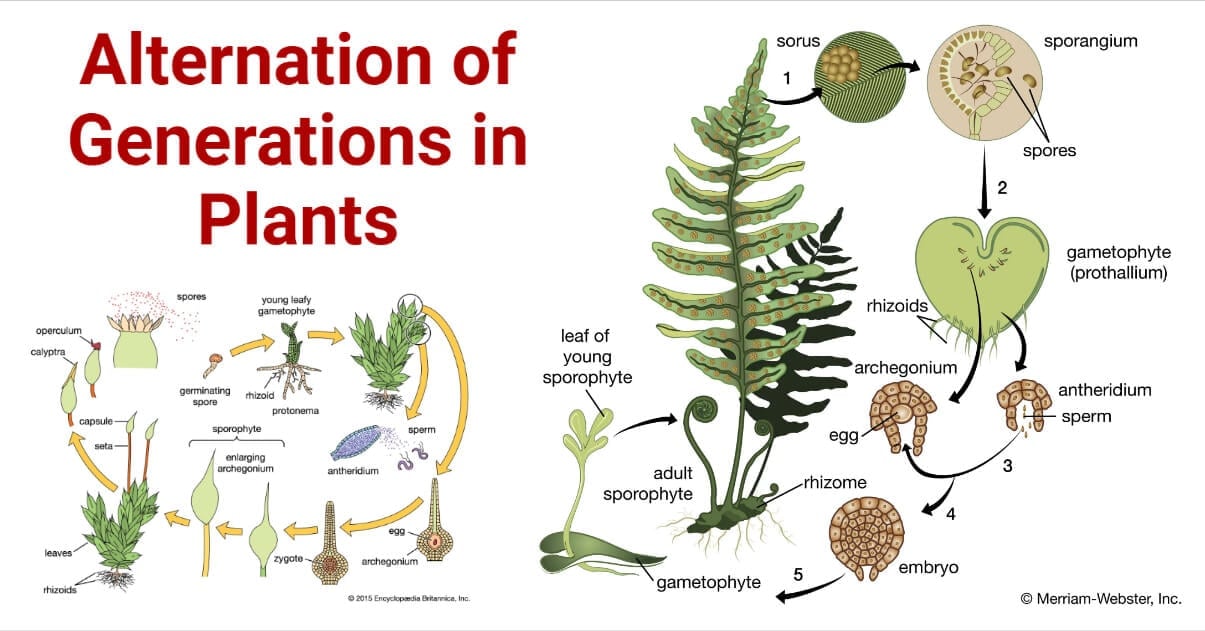Alternation of generations can be defined as a reproductive cycle of certain vascular plants, fungi, and protists in which each phase is made up of one of two distinct, free-living organisms: a gametophyte, which is frequently but not always genetically haploid, and a sporophyte, which is frequently but not always genetically diploid.
All plants alternate between sexual and asexual reproduction and between the diploid sporophyte and the haploid gametophyte. Hence, the life cycle of plants is known as the alternation of generations. The capacity of plants for both sexual and asexual reproduction helps in their capacity for environmental adaptation.

Embryonic development can only be seen only in the diploid generation. However, only haploid generation can form gametes fused to form the embryo. Therefore, it is crucial to understand how the two generations interact while studying plant development.
Interesting Science Videos
Alternation of Generations Life Cycle
It comprises two different generations, namely:
- Sporophyte generation
- Gametophyte generation
Sporophyte generation
It is an asexual phase in which a diploid (having two sets of chromosomes) plant develops and eventually produces spores. By mitosis, this sporophyte creates haploid (having a single set of chromosomes) spores germinating and developing into gametophytes for the next generation. A diploid zygote is formed when two gametes combine during fertilization. This zygote then divides through mitosis to create a new sporophyte. As soon as spores are produced, they can only influence the next phase of alternation if they are released, carried away by air and water, and land in an environment that supports germination and gametophyte growth.
Gametophyte generation
It is a sexual phase in which a haploid male and female organs (gametangia) develop and produce eggs and sperm (gametes) through simple mitosis for sexual reproduction. A zygote formed from two gametes, either from the same organism or from different members of the same species, develops into the diploid (having two sets of chromosomes) sporophyte phase, which by meiotic division produces produce unicellular spores. This cycle continues to occur.
While the sporophyte generation predominates in angiosperms and gymnosperms, the gametophyte generation is the primary life phase in bryophytes like mosses and liverworts. In fungi, the haploid phase predominates as well. Many species of algae also alternate between the sexual and asexual phases.
History
The haploid gametophyte and the diploid sporophyte are the two phases (ontogenies) that all terrestrial plants alternate between, which was recognized by German botanists Hofmeister (1851, 1862) and Strasburger (1894). Despite significant physical distinctions and variances among main groups, Hofmeister’s research revealed that the life cycle and technique of reproduction of land plants are fundamentally identical. This discovery has had a significant impact on systematic botany. It has sparked much debate about the development of life cycles and the causes of the morphological variations between gametophytes and sporophytes.
Implications for Understanding the Origin of Land Plant Life Cycles
Two evolutionary ideas have been put out regarding the life cycles of putative “green algal” progenitors to explain the genesis of the alternation of generations in terrestrial plants.
- Antithetic theory
- Alternative homologous theory
Antithetic theory
According to the Antithetic theory, terrestrial plants descended from green algae with haploid, haplobiontic life cycles and anisomorphic alternation of generations is similar to Coleochaete, a “charophycean algae.” In a haploid, haplobiontic life cycle, the sporophyte (zygote) is unicellular, and the initial sporophytic cell division is meiotic. However, the gametophyte generation is multicellular. According to this theory, the sporophyte generation of terrestrial plants descended from somatic cell divisions crosslinked in the zygote before meiosis.
Alternative homologous theory
According to the Alternative homologous theory, the first green algae had an isomorphic alternation of generations and a diplobiontic life cycle. According to this theory, several characteristics of the sporophyte and gametophyte generations of land plants may have previously existed in the algal ancestor.
Non-flowering plants’ gametophytes and sporophytes are simple to monitor and regulate. As a result, they have frequently been used to study the developmental processes that underlie the alternation of generations. Moss, such as Physcomitrella patens, is amongst them and is an early-diverging land plant, making it a suitable model to determine the origin and evolution of developmental pathways. The recent advances in plant systematics have had a significant impact on current theories regarding the evolution of alternation of generations, which are based on life cycles in existing taxa.
Advantages of Alternation of Generations
It allows species to adapt their reproductive strategies to shifting environmental conditions. An organism can reproduce asexually if it lives in a hostile environment and struggles to attract a partner. There is genetic diversity since they undergo both sexual and asexual lifecycles.
Disadvantages of Alternation of Generations
Complexity, Reproductive Isolation, Competition for Resources, and Genetic Load.
References
- Graham, L. K., & Wilcox, L. W. (2000). The origin of alternation of generations in land plants: a focus on matrotrophy and hexose transport. Philosophical transactions of the Royal Society of London. Series B, Biological sciences, 355(1398), 757–767. https://doi.org/10.1098/rstb.2000.0614
- Horst, N. A., & Reski, R. (2016). Alternation of generations – unravelling the underlying molecular mechanism of a 165-year-old botanical observation. Plant biology (Stuttgart, Germany), 18(4), 549–551. https://doi.org/10.1111/plb.12468
- Kenrick, P. (1994). Alternation of Generations in Land Plants: New Phylogenetic and Palaeobotanical Evidence. Biol. Rev. 69, pp. 293-330
- Sheffield, E. (2008). Alternation of generations. In T. Ranker & C. Haufler (Eds.), Biology and Evolution of Ferns and Lycophytes (pp. 49-74). Cambridge: Cambridge University Press. doi:10.1017/CBO9780511541827.003
- Britannica, T. Editors of Encyclopaedia (2019). alternation of generations. Encyclopedia Britannica. https://www.britannica.com/science/alternation-of-generations
- Gilbert SF. Developmental Biology. 6th edition. Sunderland (MA): Sinauer Associates; 2000. Plant Life Cycles. Available from: https://www.ncbi.nlm.nih.gov/books/NBK9980/

Since there’s meiosis in the sporophyte generation,I thought there would be genetic diversity but your saying it’s not according to the disadvantage you gave up
Hi, yes, there would be genetic diversity. I have corrected the article. Thanks for the correction.